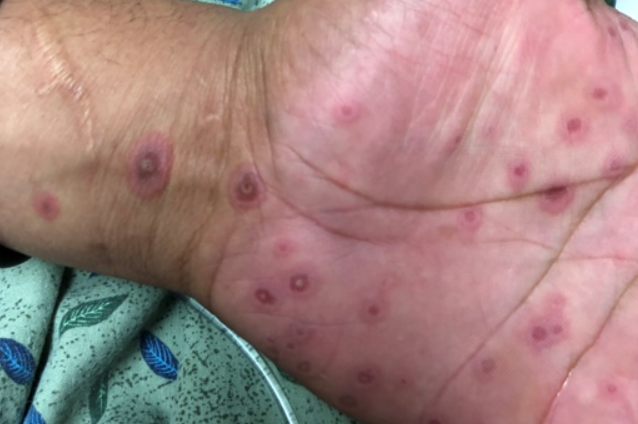Erythema multiforme is an acute immunoinflammatory reaction of the skin and, in some cases, mucous membranes in response to various stimulations. It is characterized by target-like lesions with peripheral localization that tend to recur and resolve spontaneously. ICD-10 Code: L51
In most cases, the development of erythema multiforme is associated with herpes infection, but it can also occur with hepatitis B and C viruses, Epstein-Barr virus, adenoviruses, mycoplasma pneumoniae, bacterial and fungal microorganisms. The disease may be triggered by the use of certain medications (sulfonamides, penicillins, barbiturates, allopurinol, phenylbutazone). The underlying mechanisms involve toxic-allergic reactions leading to the formation of immune complexes and deposition of IgM and C3 complement in the blood vessels of the skin.
Erythema multiforme can affect individuals of any age, but is more common in adolescents and young adults. It predominantly affects males (male to female ratio is 3:2). About 30% of cases are recurrent. It is less common in children (20% of cases).Clinical picture is characterized by an acute onset. The disease often begins with prodromal symptoms (fever, malaise, muscle and joint pains, sore throat).
After the prodromal period, erythema multiforme appears suddenly (over a period of 10-15 days or more).
Primary morphologic elements are hyperemic spots (erythema), papules and blisters. The papules are round with clear borders, from 0.3 to 1.5 cm in size, reddish-blue in color, flat, firm to the touch, with a tendency to central growth with a “sinking” central part.
- A central disk of dark erythema or purpura, which may become necrotic or transform into a firm blister.
- A ring of palpable pale edematous area.
- An exterior ring of erythema.
Subjectively, the eruptions are accompanied by itching. Pathologic elements tend to coalesce, forming garlands and arches. Blisters are round, small, flat, with a thick rim, typically filled with opalescent fluid and usually located in the center of papules.
Secondary morphologic elements include erosions, crusts, scales, hyperpigmented spots, which have no clinical peculiarities.
The eruptions usually appear suddenly, more often in the periphery, symmetrically on the skin of the dorsum of the feet and hands, palms, extensor surfaces of the forearms and shins. Involvement of the eyes and genitals is less common. Blisters may form on the mucous membranes, which may rupture to form painful erosions. The eruptions take 2-3 weeks to heal without leaving scars. Pigmented spots that appear in the place of former papules are characterized by a yellowish-brown color.
- Erythema nodosum
- Fixed drug eruption
- Erythema annulare centrifugum
- Rowell's syndrome
- Chilblains
Topical therapy:
Aniline dye solutions are used for treating erosions.
Topical steroids:
- Methylprednisolone acetate 0.1%, cream, applied to affected areas twice a day for 2 weeks, or
- Hydrocortisone butyrate 0.1%, applied to affected areas twice a day for 2 weeks, or
- Betamethasone valerate 0.1%, applied to affected areas twice a day for 2 weeks.
Combined topical glucocorticoids + antibiotics:
- Betamethasone valerate + gentamicin sulfate applied to affected areas twice a day for 2 weeks.
Systemic therapy:
In case of secondary infection or association with Mycoplasma pneumoniae, systemic antibacterial agents are indicated:
- Erythromycin, 0.5-1.0 g orally three times a day for 2 weeks.
Antihistamine drugs:
- Levocetirizine 5 mg orally once a day for 7-10 days.
- Cetirizine 10 mg orally once a day for 7-10 days, or
- Loratadine 10 mg orally once a day for 7-10 days, or
- Clemastine 1 mg orally 2-3 times a day or intramuscularly for 7-10 days, or
- Mebhydroline 0.1 g orally 1-3 times a day for 7-10 days, or
- Dimethindene 4 mg orally once a day for 7-10 days, or
Systemic glucocorticoids are prescribed for severe cases:
- Prednisone 30-50 mg per day orally or 0.5-1 mg per kg of body weight with gradual dose reduction over 2 weeks, or
- Dexamethasone 4-8 mg per day orally.
The dose of systemic glucocorticoids is gradually reduced to complete discontinuation as the eruptions regress.
When associated with herpes simplex virus, one of the antiviral drugs is prescribed:
- Acyclovir 200 mg orally 5 times a day for 5-7 days, or
- Valacyclovir 500 mg orally twice a day for 5-10 days, or
- Famciclovir 250 mg orally twice a day for 7 days.
In cases of recurrent disease, prophylactic and preventive treatment is recommended, such as acyclovir 400 mg orally twice daily for prolonged periods.
For patients without a history of herpes simplex virus infection, the following options may be considered:
- Dapsone 100-150 mg per day.
- Hydroxychloroquine 200-400 mg per day.
- Azathioprine 100-150 mg per day.
Prevention:
Regular antiviral medication reduces the likelihood of herpes simplex virus recurrences, especially in the spring.


